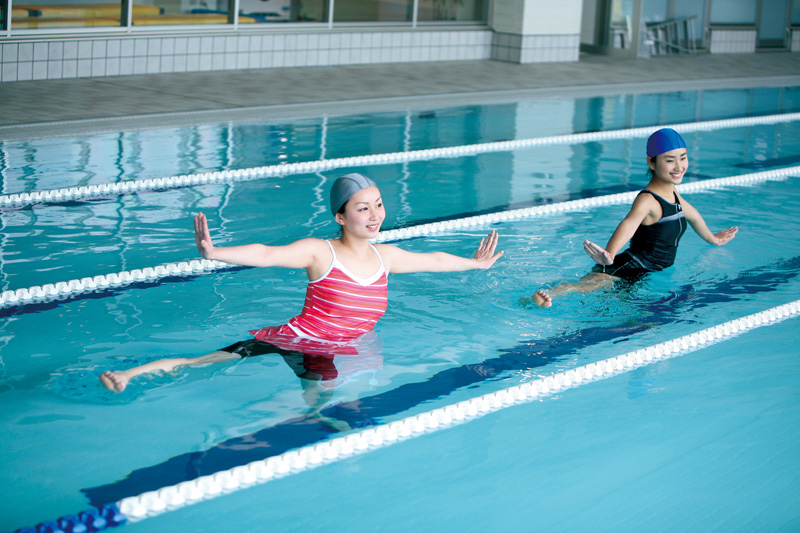FRP Pools: Products of Adapting and Optimizing Materials
Introducing the stories behind Yamaha Motor's technologies.

It is said that the percentage of Japanese elementary, middle and high schools with swimming pools is one of the highest in the world. About half of these are FRP (fiber-reinforced plastic) pools, with the rest being made of stainless steel or concrete. Of the FRP pools in Japan, roughly 96% are made by Yamaha Motor, and the underlying know-how that has made these pools so successful is a well-integrated combination of optimizing the material make-up of the FRP, manufacturing technology, on-site assembly skills that enable millimeter-level precision, and more.
Yamaha Motor began research and development of FRP soon after the company was founded in the latter half of the 1950s. After bringing FRP boats to market, Yamaha realized that FRP’s excellent durability, weather-resistance and earthquake-resistance would make it a very good material for making swimming pools. This led Yamaha to create and release Japan’s first all-FRP pool in 1974, named the “Family Pool.” Then in 1976, we released the “Swimming Pool” designed for private home use. In 1978, the first Yamaha 25-meter school pool, named the “School 25,” was delivered and installed. Since then, Yamaha FRP pools have continued to be produced, delivered and installed for use at schools around the country to this day.
The first reason behind the popularity of these FRP pools is their light weight. One reason that their lightness is an advantage is that it makes it possible to install the pools even on the roofs of schools located in congested urban centers, where space is often limited as well as expensive. Putting a pool on the roof also protects the privacy of the students swimming, and there are some cases where schools consider them a substitute water source for times of emergency or disaster. There are also cases of swimming school facilities where the ground floor is used as a parking area and the pool is located on the second floor.
The next reason FRP pools are popular is the way they can be freely shaped with smoothly curved surfaces and edges. FRP pools are known for being able to fit the diverse range of necessities for special-needs schools and their students. They are also recognized for their good heat-retention qualities when used for heated pools. FRP pools take less time to install, too; small, easy-to-transport pool sections are manufactured and sent to the delivery location where they are then assembled on-site, so there is no worry about sufficiently wide road access.
However, Yamaha didn’t simply apply its FRP boatbuilding technology and know-how to its FRP pools as is. Though the FRP used for Yamaha pools is basically the same as the FRP used for our boats, there are differences in the coats of finish used on the side exposed to the water, the plastic resin used on the other side and more. In the case of boats, hull strength and resistance to ultraviolet light are important, but for pools, a major concern is the presence of chlorine to keep the water clean. Weatherproofing and compatibility with chlorinated water are mutually opposed qualities, so the FRP material for a pool has to be specifically tweaked to meet these requirements.
The assembly work involved in FRP pool construction is also important. An FRP pool is manufactured at the factory in side-wall sections and floor (pool bottom) sections measuring about 2 x 7 meters. These are then put together and the section joints are sealed on-site. This job requires construction workers with special skills, and in the case of authorizing a pool for competitive swimming, the final pool dimensions must be precise down to a millimeter scale in order to be approved for use. When the pool is filled with water, there is little variance in the pool’s size in terms of contraction or expansion, but when it is empty, changes in the outdoor temperature can alter size by ±10 mm in the case of a 50-meter pool. That’s why the unit sections of the pool are designed and manufactured with concern for this characteristic of FRP as a material.
Yamaha FRP pools, which are also now being supplied to Taiwan and South Korea, originated from a unique idea. Pools are typically built either in an outside land lot or in buildings, but Yamaha saw pools not as “structures” but as “industrial products” that could be manufactured at a factory to fit a variety of environments, conditions or types of use, and then delivered and installed for the client. This example of Yamaha originality comes from our corporate stance of always serving as an interface between people and our products and equipment.
Related Link
Yamaha FRP Swimming Pools (in Japanese only)

